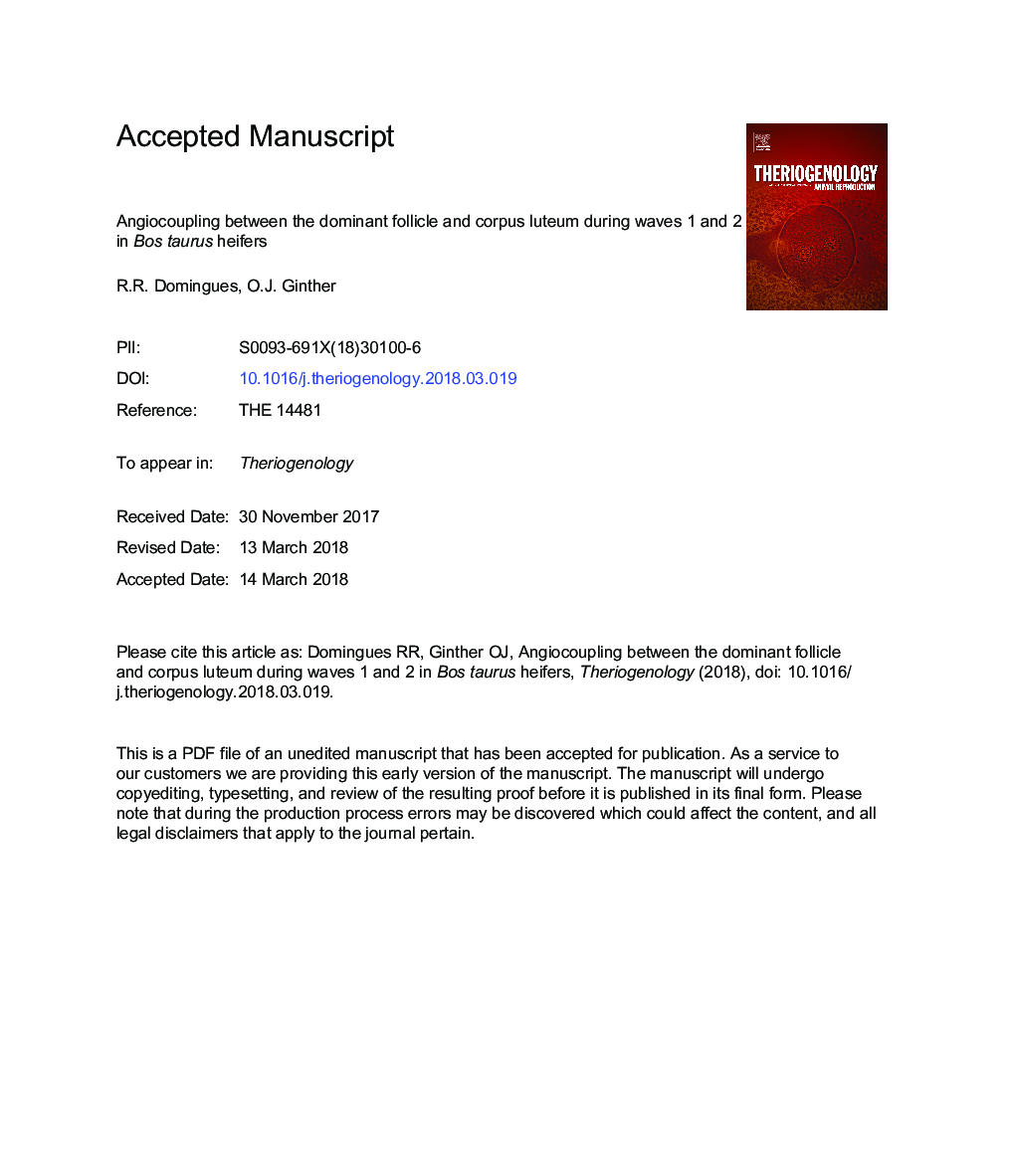| کد مقاله | کد نشریه | سال انتشار | مقاله انگلیسی | نسخه تمام متن |
|---|---|---|---|---|
| 8426895 | 1546055 | 2018 | 32 صفحه PDF | دانلود رایگان |
عنوان انگلیسی مقاله ISI
Angiocoupling between the dominant follicle and corpus luteum during waves 1 and 2 in Bos taurus heifers
ترجمه فارسی عنوان
آنژیوکوپلیک بین فولیکول غالب و کبد قرمز در طوفانهای 1 و 2 در تلیسههای بوس تاوروس
دانلود مقاله + سفارش ترجمه
دانلود مقاله ISI انگلیسی
رایگان برای ایرانیان
کلمات کلیدی
آنژیووکوپل، جریان خون، کبد لوتئوم، فولیکول غالب آتلیه فولیکول،
موضوعات مرتبط
علوم زیستی و بیوفناوری
علوم کشاورزی و بیولوژیک
علوم دامی و جانورشناسی
چکیده انگلیسی
The local two-way effect of the future and established dominant follicle (DF) and corpus luteum (CL) on color-Doppler signals of blood flow on each other (angiocoupling) was studied from ovulation to 16 days after ovulation during wave 1 and for the first time in wave 2 in Bos taurus heifers (Nâ¯=â¯24). Identity of follicles greater than 4â¯mm was maintained from day to day. Blood-flow signals in the follicle wall and in the CL were estimated after scanning the entire structure. Ovarian patterns were defined based on the presence of a DF and CL: DFâCL pattern (DF and CL in the same ovary), DF pattern or CL pattern (DF and CL in opposite ovaries), and devoid pattern (neither DF nor CL). Comparisons were made of blood flow in each structure when in the same ovary vs opposite ovaries. Data were normalized to expected diameter deviation (DF closest to 8.5â¯mm). Blood-flow signals were detected in most growing follicles when they attained 6â¯mm (6.0-6.9â¯mm). Combined for waves 1 and 2, the percentage of all 6-mm growing follicles that displayed blood-flow signals was greater (Pâ¯<â¯0.0001) for the DFâCL pattern (21/26, 81%) than for the patterns of DF alone, CL alone, or neither DF nor CL (total for the three patterns (17/42, 40.5%); there was no effect of left vs right ovaries. For each wave, the percentage of DF wall and percentage of CL tissue with blood-flow signals were greater for the DFâCL pattern vs the DF pattern or CL pattern. Percentage of DF wall with blood-flow signals for the DFâCL vs DF patterns was 30.0â¯Â±â¯1.5% vs 19.5â¯Â±â¯1.1% (Pâ¯<â¯0.02) in wave 1 and 30.8â¯Â±â¯1.3% vs 20.2â¯Â±â¯1.1% (Pâ¯<â¯0.0001) in wave 2. Percentage of CL tissue with blood-flow signals for the DFâCL vs CL patterns was 61.7â¯Â±â¯2.4% vs 56.9â¯Â±â¯1.7% (Pâ¯<â¯0.03) in wave 1 and 78.8â¯Â±â¯1.3% vs 74.0â¯Â±â¯0.9% (Pâ¯<â¯0.03) in wave 2. During wave 1, the percentage of CL tissue with blood-flow signals was greater (Pâ¯<â¯0.002) when the DF and CL were in close proximity (distance between structures, < 2â¯mm; 66.9â¯Â±â¯3.0%) than when separated (â¥2â¯mm; 53.8â¯Â±â¯3.5%). Normalization to the maximal DF diameter in wave 1 resulted in the novel finding that the percentage of blood-flow signals in the DF wall began to decrease 1 day before maximal diameter. Results supported the hypotheses that (1) percentage of DF wall and CL tissue with blood-flow signals in wave 2 is greater in the DFâCL pattern than in the DF or CL patterns and (2) percentage of DF wall with blood-flow signals in wave 1 decreases before the beginning of a decrease in diameter.
ناشر
Database: Elsevier - ScienceDirect (ساینس دایرکت)
Journal: Theriogenology - Volume 114, 1 July 2018, Pages 109-115
Journal: Theriogenology - Volume 114, 1 July 2018, Pages 109-115
نویسندگان
R.R. Domingues, O.J. Ginther,
